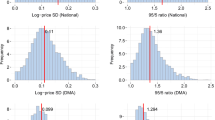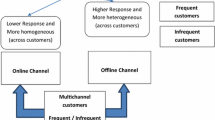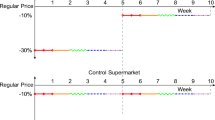Abstract
This study empirically estimates the expected basket-level demand effects, as well as the expected store profit effects, of three different customization levels of retailer promotions. Using data from a national grocery retailer in the U.S., we estimate a household’s contemporaneous purchase incidence outcomes in 28 frequently shopped categories. Estimating the cross-category dependencies in purchase incidence as a function of exposure to levels of customized promotions, allows us to measure the effect of each campaign on expected retailer profit and implement prescriptive analytics to identify the appropriate multi-level coupon mix for maximizing profits. We find all three levels of coupon customization result in per-customer returns, but that medium customization leads to the highest incremental expected profit, while high customization generates the highest expected profit. The results provide insights to retailers about investing in more customized promotional efforts, with a detailed cross-category perspective into where such value is gained.
Graphical abstract








Similar content being viewed by others
Notes
“Active” indicates the weeks in which the coupon was still good (i.e., had not expired) after it was received.
This is because only a subset of the 800 households purchase in these categories over the study period, and even these households purchase only once over the 102 weeks.
In the estimation, we find that the 800 households in our dataset fall under 750 unique multi-category heterogeneous support points, which reflects a very high degree of heterogeneity across households.
Category shelf price is not used as an explanatory variable since time-varying product prices were not made available to us by the retailer.
For 17 categories, the 2-support distribution is found to be the most appropriate, while for the remaining 11 categories, the homogeneous solution is found to be the most appropriate, based on BIC.
Another interpretation is that customers with higher purchase frequencies joined the loyalty program earlier.
In Web Appendix (Figs. 1 to 6), we plot the expected store profits for all 6 different types of retailer targeted coupons campaigns, including the 3 sub-Type A coupons (i.e., favorite product, favorite brand and category).
The only noticeable negative cross-category spillover occurs for nuts, which could be due to the fact that nuts are a protein substitute.
The only estimated negative cross-category effect is for in-store photo finishing products.
References
Bell, D.R., T. Ho, and C.S. Tang. 1998. Determining where to shop: Fixed and variable costs of shopping. Journal of Marketing Research 35 (3): 352–369.
Bell, D.R., and J.M. Lattin. 1998. Shopping behavior and consumer preference for store price format: Why “Large Basket” shoppers prefer EDLP. Marketing Science 17: 1.
Ben-Akiva, Moshe, and S.R. Lerman. 1985. Discrete choice analysis. Cambridge: MIT Press.
Besag, J. 1974. Spatial interaction and the statistical analysis of lattice systems. The Journal of the Royal Statistical Society, Series B 36 (1): 192–236.
Bodapati, A.V. 2008. Recommendation systems with purchase data. Journal of Marketing Research 45 (1): 77–93.
Chib, S., P.B. Seetharaman, and A. Strijnev. 2002. Analysis of multi-category purchase incidence decisions using IRI market basket data. In Adv. in Econ. 57–92. Emerald Group Pub. Ltd.
Chintagunta, P.K., and J. Chu. 2011. Category selection and store choice modeling. Working Paper, Booth School of Business. Chicago: Univ. of Chicago.
Chu, W., and J. Joo. 2022. Targeting effectiveness of mobile coupons: From exposure to purchase. Journal of Marketing Analytics. https://doi.org/10.1057/s41270-022-00200-8.
Dreze, X., and J. Nunes. 2011. Recurring goals and learning: The impact of successful reward attainment on purchase behavior. Journal of Marketing Research 48 (2): 268–281.
Gopalakrishnan, A., and Y.H. Park. 2021. The impact of coupons on the visit-to-purchase funnel. Marketing Science 40 (1): 48–61.
Hruschka, H., M. Lukanowicz, and C. Buchta. 1999. Cross-category sales promotion effects. Journal of Retailing and Consumer Services 6 (1): 99–105.
Kamakura, W.A., and G.J. Russell. 1989. A probabilistic choice model for market segmentation and elasticity structure. Journal of Marketing Research 26 (4): 379–390.
Kantar Media. 2018. Print & digital promotion trends: The view from above https://www.kantarmedia.com/us/thinking-and-resources/blog/2018-print-digital-promotion-trends-the-view-from-above.
Kim, J. 2019. The impact of different price promotions on customer retention. Journal of Retailing and Consumer Services 46 (1): 95–102.
Klabjan, D., and J. Pei. 2011. In-store one-to-one marketing. Journal of Retailing and Consumer Services 18 (1): 64–73.
Lewis, M. 2004. The influence of loyalty programs and short-term promotions on customer retention. Journal of Marketing Research 41 (3): 281–292.
Li, Z., W. Yang, H.S. Jin, and D. Wang. 2021. Omnichannel retailing operations with coupon promotions. Journal of Retailing and Consumer Services 58: 102324.
Lin, C., and D. Bowman. 2022. The impact of introducing a customer loyalty program on category sales and profitability. Journal of Retailing and Consumer Services 64 (1): 102769.
Liu, Y. 2007. The long-term impact of loyalty programs on consumer purchase behavior and loyalty. Journal of Marketing 71 (4): 19–35.
Manchanda, P., A. Ansari, and S. Gupta. 1999. The shopping basket: A model for multicategory purchase incidence decisions. Marketing Science 18 (2): 95–114.
Manchanda, P., P.E. Rossi, and P.K. Chintagunta. 2004. Response modeling with nonrandom marketing-mix variables. Journal of Marketing Research 41 (4): 467–478.
Mehta, N. 2007. Investigating consumers’ purchase incidence and brand choice decisions across multiple product categories: A theoretical and empirical analysis. Marketing Science 26 (2): 196–217.
Mehta, N., and Y. Ma. 2012. A multicategory model of consumers’ purchase incidence, quality, and brand choice decisions: Methodological issues and implications on promotional decisions. Journal of Marketing Research 49 (4): 435–451.
Moodley, R., F. Chiclana, F. Caraffini, and J. Carter. 2020. A product-centric data mining algorithm for targeting promotions. Journal of Retailing and Consumer Services 54 (5): 101940.
Mou, S., D.J. Robb, and N. DeHoratius. 2018. Retail store operations: Literature review and research directions. The European Journal of Operational Research 265 (2): 399–422.
Nesset, E., O. Bergem, B. Nervik, E.S. Sorlie, and O. Helgesen. 2021. Building chain loyalty in grocery retailing by means of loyalty programs—A study of ‘the Norwegian case.’ Journal of Retailing and Consumer Services 60 (5): 102450.
Niraj, R., V. Padmanabhan, and P.B. Seetharaman. 2008. A cross-category model of households’ incidence and quantity decisions. Marketing Science 27 (2): 225–235.
Osuna, I., J. González, and J. Capizzani. 2016. Which categories and brands to promote with targeted coupons to reward and to develop customers in supermarkets. Journal of Retailing 92 (2): 236–251.
Pancras, J., and K. Sudhir. 2007. Optimal marketing strategies for a customer data intermediary. Journal of Marketing Research 44 (4): 560–578.
Rains, T., and P. Longley. 2021. The provenance of loyalty card data for urban and retail analytics. Journal of Retailing and Consumer Services 63 (11): 102650.
Reimers, I., and C. Xie. 2019. Do coupons expand or cannibalize revenue? Evidence from an e-Market. Management Science 65 (1): 286–300.
Rossi, P.E., R.E. McCulloch, and G.M. Allenby. 1996. The value of purchase history data in target marketing. Marketing Science 15 (4): 321–340.
Russell, G., and A. Peterson. 2000. Analysis of cross-category dependence in market basket selection. The Journal of Retailing 73 (4): 439–461.
Sewell, D. 2009. Kroger uses shopper data to target coupons. Assoc. Press, Jan. 6.
Shaohui, M., and R. Fildes. 2017. A retail store SKU promotions optimization model for multi-period profit maximization. The European Journal of Operational Research 260 (2): 680–692.
Van Heerde, H.J., and T.H. Bijmolt. 2005. Decomposing the promotional revenue bump for loyalty program members versus nonmembers. Journal of Marketing Research 42 (4): 443–457.
Venkatesan, R., and P.W. Farris. 2012. Measuring and managing returns from retailer-customized coupon campaigns. Journal of Marketing 76 (1): 76–94.
Zeybek, O., and B. Ulengin. 2022. The effect of sales promotions intensity on volume and variability in category sales of large retailers. Journal of Marketing Analytics 10: 19–29.
Zhang, J., and L. Krishnamurthi. 2004. Customizing promotions in online stores. Marketing Science 23 (4): 561–578.
Zhang, J., and M. Wedel. 2009. The effectiveness of customized promotions in online and offline Stores. Journal of Marketing Research 46 (2): 190–206.
Zhu, T., and V. Singh. 2009. Spatial competition with endogenous location choices: An application to discount retailing. Quantitative Marketing and Economics 7 (1): 1–35.
Funding
The authors have no funding to report.
Author information
Authors and Affiliations
Corresponding author
Ethics declarations
Conflict of interest
The authors certify that they have no affiliations with or involvement in any organization or entity with any financial interest or nonfinancial interest in the subject matter or materials discussed in this manuscript.
Additional information
Publisher's Note
Springer Nature remains neutral with regard to jurisdictional claims in published maps and institutional affiliations.
Supplementary Information
Below is the link to the electronic supplementary material.
Rights and permissions
Springer Nature or its licensor (e.g. a society or other partner) holds exclusive rights to this article under a publishing agreement with the author(s) or other rightsholder(s); author self-archiving of the accepted manuscript version of this article is solely governed by the terms of such publishing agreement and applicable law.
About this article
Cite this article
Chaudhry, A., Heilman, C. & Seetharaman, P.B. Measuring the effects of customized targeted promotions on retailer profits: prescriptive analytics using basket-level econometric analysis. J Market Anal (2023). https://doi.org/10.1057/s41270-023-00253-3
Revised:
Accepted:
Published:
DOI: https://doi.org/10.1057/s41270-023-00253-3




